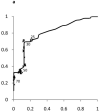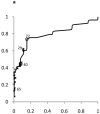SAFETY study: alanine aminotransferase cutoff values are set too high for reliable detection of pediatric chronic liver disease
- PMID: 20064512
- PMCID: PMC2846968
- DOI: 10.1053/j.gastro.2009.12.052
SAFETY study: alanine aminotransferase cutoff values are set too high for reliable detection of pediatric chronic liver disease
Abstract
Background & aims: The appropriate alanine aminotransferase (ALT) threshold value to use for diagnosis of chronic liver disease in children is unknown. We sought to develop gender-specific, biology-based, pediatric ALT thresholds.
Methods: The Screening ALT for Elevation in Today's Youth (SAFETY) study collected observational data from acute care children's hospitals, the National Health and Nutrition Examination Survey (NHANES, 1999-2006), overweight children with and without non-alcoholic fatty liver disease (NAFLD), and children with chronic hepatitis B virus (HBV) or hepatitis C virus (HCV) infections. The study compared the sensitivity and specificity of ALT thresholds currently used by children's hospitals vs study-derived, gender-specific, biology-based, ALT thresholds for detecting children with NAFLD, HCV, or HBV.
Results: The median upper limit of ALT at children's hospitals was 53 U/L (range, 30-90 U/L). The 95th percentile levels for ALT in healthy weight, metabolically normal, liver disease-free, NHANES pediatric participants were 25.8 U/L (boys) and 22.1 U/L (girls). The concordance statistics of these NHANES-derived thresholds for liver disease detection were 0.85 (95% confidence interval [CI]: 0.74-0.96) in boys and 0.91 (95% CI: 0.83-0.99) in girls for NAFLD, 0.80 (95% CI: 0.70-0.91) in boys and 0.79 (95% CI: 0.69-0.89) in girls for HBV, and 0.86 (95% CI: 0.77-0.95) in boys and 0.84 (95% CI: 0.75-0.93) in girls for HCV. Using current children's hospitals ALT thresholds, the median sensitivity for detection of NAFLD, HBV, and HCV ranged from 32% to 48%; median specificity was 92% (boys) and 96% (girls). Using NHANES-derived thresholds, the sensitivities were 72% (boys) and 82% (girls); specificities were 79% (boys) and 85% (girls).
Conclusions: The upper limit of ALT used in children's hospitals varies widely and is set too high to reliably detect chronic liver disease. Biology-based thresholds provide higher sensitivity and only slightly less specificity. Clinical guidelines for use of screening ALT and exclusion criteria for clinical trials should be modified.
Keywords: clinical trials; hepatitis; nonalcoholic fatty liver disease; obesity; patient safety.
2010 AGA Institute. Published by Elsevier Inc. All rights reserved.
Figures







Similar articles
-
Normal serum alanine aminotransferase and non-alcoholic fatty liver disease among Korean adolescents: a cross-sectional study using data from KNHANES 2010-2015.BMC Pediatr. 2018 Jul 5;18(1):215. doi: 10.1186/s12887-018-1202-z. BMC Pediatr. 2018. PMID: 29976192 Free PMC article.
-
Upper limits of normal for serum alanine aminotransferase levels in Chinese Han population.PLoS One. 2012;7(9):e43736. doi: 10.1371/journal.pone.0043736. Epub 2012 Sep 4. PLoS One. 2012. PMID: 22962588 Free PMC article.
-
Updated upper limits of normal serum alanine aminotrasferase levels for screening metabolic dysfunction-associated fatty liver disease in obese children.J Formos Med Assoc. 2022 Dec;121(12):2548-2555. doi: 10.1016/j.jfma.2022.06.002. Epub 2022 Jun 21. J Formos Med Assoc. 2022. PMID: 35738972
-
Does the hepatologist still need to rely on aminotransferases in clinical practice? A reappraisal of the role of a classic biomarker in the diagnosis and clinical management of chronic liver diseases.Ann Hepatol. 2025 Jan-Jun;30(1):101900. doi: 10.1016/j.aohep.2025.101900. Epub 2025 Mar 13. Ann Hepatol. 2025. PMID: 40089150 Review.
-
Aminotransferase levels in clinical practice - what is normal?Curr Opin Gastroenterol. 2025 Jul 1;41(4):260-264. doi: 10.1097/MOG.0000000000001094. Epub 2025 Apr 9. Curr Opin Gastroenterol. 2025. PMID: 40227983 Review.
Cited by
-
Comparison of Controlled Attenuation Parameter and Liver Biopsy to Assess Hepatic Steatosis in Pediatric Patients.J Pediatr. 2016 Jun;173:160-164.e1. doi: 10.1016/j.jpeds.2016.03.021. Epub 2016 Mar 30. J Pediatr. 2016. PMID: 27039224 Free PMC article.
-
Comparison of Body Composition, Muscle Strength and Cardiometabolic Profile in Children with Prader-Willi Syndrome and Non-Alcoholic Fatty Liver Disease: A Pilot Study.Int J Mol Sci. 2022 Dec 1;23(23):15115. doi: 10.3390/ijms232315115. Int J Mol Sci. 2022. PMID: 36499438 Free PMC article.
-
Clinical Practice Guideline for the Diagnosis and Treatment of Pediatric Obesity: Recommendations from the Committee on Pediatric Obesity of the Korean Society of Pediatric Gastroenterology Hepatology and Nutrition.Pediatr Gastroenterol Hepatol Nutr. 2019 Jan;22(1):1-27. doi: 10.5223/pghn.2019.22.1.1. Epub 2019 Jan 10. Pediatr Gastroenterol Hepatol Nutr. 2019. PMID: 30671370 Free PMC article. Review.
-
Upper Normal Alanine Aminotransferase Range and Insulin Resistance in Korean Adolescents: Korean National Health and Nutrition Examination Survey, 2009-2010.Dig Dis Sci. 2016 Jun;61(6):1700-6. doi: 10.1007/s10620-015-4009-x. Epub 2015 Dec 24. Dig Dis Sci. 2016. PMID: 26703124
-
A novel system for predicting liver histopathology in patients with chronic hepatitis B.Medicine (Baltimore). 2017 Apr;96(14):e6465. doi: 10.1097/MD.0000000000006465. Medicine (Baltimore). 2017. PMID: 28383410 Free PMC article.
References
-
- Jonas MM. Children with hepatitis C. Hepatology. 2002;36:S173–178. - PubMed
-
- Barlow S, the Expert Committee Expert Committee Recommendations on the Assessment, Prevention, and Treatment of Child and Adolescent Overweight and Obesity, Summary Report. Pediatrics. 2007;120:S164–S192. - PubMed
-
- Prati D, Taioli E, Zanella A, et al. Updated definitions of healthy ranges for serum alanine aminotransferase levels. Ann Intern Med. 2002;137:1–10. - PubMed
Publication types
MeSH terms
Substances
Grants and funding
LinkOut - more resources
Full Text Sources
Medical

